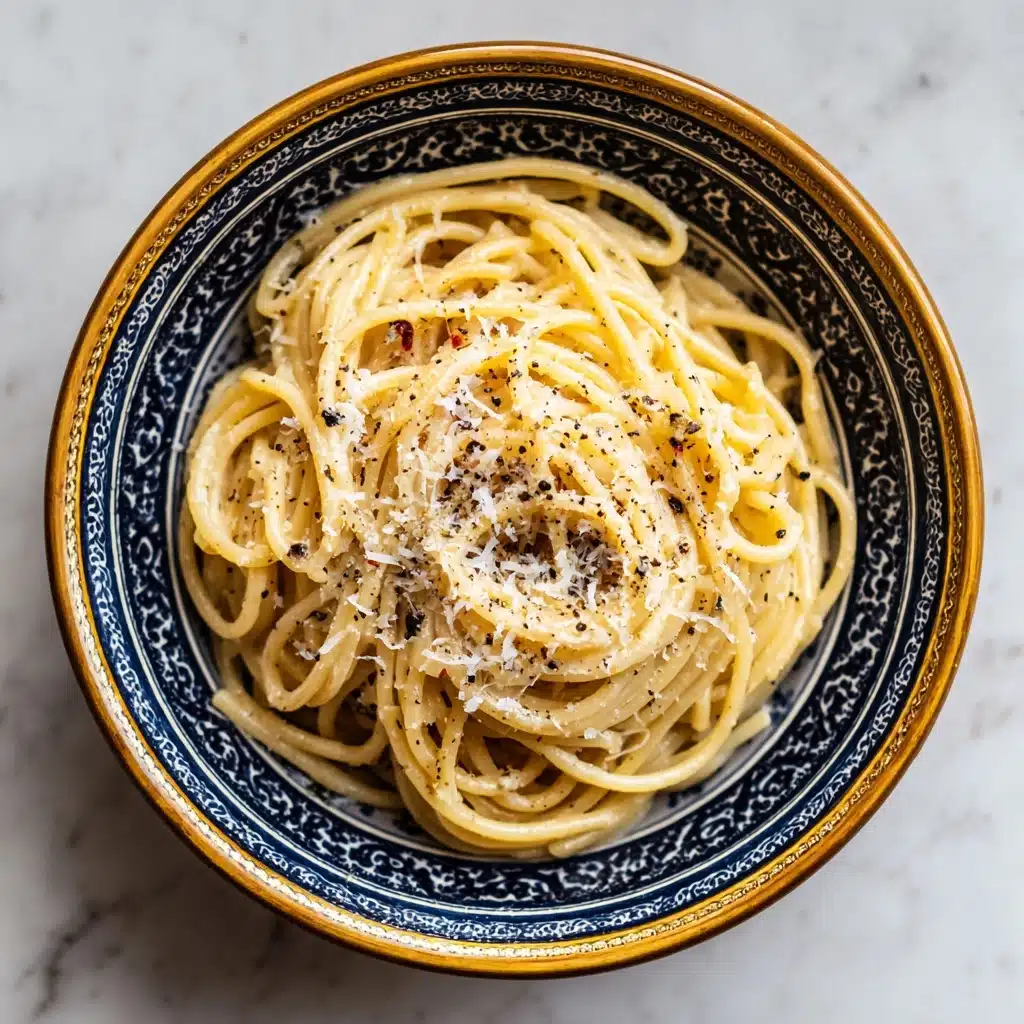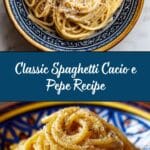If you’ve ever craved the pure magic of Italian cuisine—salty, creamy, just a bit peppery, and absolutely impossible to stop eating—then Spaghetti Cacio e Pepe is about to become your newest obsession. This centuries-old Roman classic does the impossible: it transforms a handful of humble ingredients into a deeply comforting dish that delivers major flavor in every twirl of your fork. Whether you’re channeling your inner nonna or just want to wow your friends with something special, Spaghetti Cacio e Pepe adds easy elegance to your table and proves (yet again) that less really can be more.
Ingredients You’ll Need
Spaghetti Cacio e Pepe is all about simplicity—with every ingredient shining through, working together to create that luscious sauce and signature boldness. Use the best quality you can find, as each element plays a starring role in flavor, texture, and even the visual appeal.
- Spaghetti: Go for traditional spaghetti as it holds the creamy sauce beautifully and delivers that classic texture in every bite.
- Pecorino Romano cheese: Freshly grated is a must! Its sharp, salty profile is essential for the signature taste of Spaghetti Cacio e Pepe.
- Freshly ground black pepper: Don’t skimp here—the pepper is so much more than an afterthought, providing aroma and gentle heat.
- Unsalted butter: Adds creaminess and enriches the sauce without overpowering the cheese and pepper.
- Olive oil: A touch helps meld everything together, lending silkiness and savory Mediterranean notes.
- Salt (for pasta water): Seasoning the pasta water is crucial—think of it as your first chance to flavor the whole dish.
How to Make Spaghetti Cacio e Pepe
Step 1: Cook the Spaghetti
Set a large pot of water on the stove, add a generously sized spoonful of salt, and bring it to a rolling boil. Add your spaghetti, stirring occasionally, and cook until it’s perfectly al dente—still firm to the bite. Before draining, make sure to reserve about 1 1/2 cups of the starchy pasta water; this magical liquid is what helps create the signature creamy sauce of Spaghetti Cacio e Pepe.
Step 2: Toast the Black Pepper
Grab your largest skillet and add the freshly ground black pepper right in—no oil yet! Let it toast on medium heat for 1 to 2 minutes. Toasting unlocks the pepper’s floral aroma and takes the sharp edge off, giving Spaghetti Cacio e Pepe its complex warmth and depth.
Step 3: Build the Pepper Sauce
Once the pepper is fragrant, add the butter and a splash of olive oil. Let them melt together, swirling the pan so everything fuses. Pour in about one cup of that reserved pasta water, turning the mixture into a light, peppery broth. This is the start of your sauce—and it’s already smelling incredible!
Step 4: Toss the Spaghetti
Add the drained spaghetti straight into your skillet. Toss and twirl, coating each strand completely in the peppery sauce. Doing this over gentle heat helps the pasta soak up all those delicious flavors, laying the groundwork for the cheese to melt beautifully in the next step.
Step 5: Stir in the Pecorino Romano
Take the pan off the heat (this is key so the cheese doesn’t clump). Immediately sprinkle in the finely grated Pecorino Romano, then toss, toss, toss! The cheese and pasta water meld with the spaghetti, transforming into a rich and glossy sauce. It’s normal for this process to look a little wild at first, but keep going—you’ll see it come together! If needed, add a splash more pasta water until it’s creamy and coats every strand.
How to Serve Spaghetti Cacio e Pepe

Garnishes
Top your steaming plates of Spaghetti Cacio e Pepe with an extra flurry of freshly grated Pecorino Romano and an extra scatter of black pepper. These final touches aren’t just decorative—the cheese boosts that unmistakable sharp, salty edge, and the pepper adds a fragrant kick right before you dig in.
Side Dishes
Pair Spaghetti Cacio e Pepe with something simple, letting the main dish shine. Think crisp arugula salad, roasted asparagus, or perhaps oven-warmed crusty bread to mop up every last bit of sauce. A chilled glass of dry white wine is the ideal companion to cut through the richness.
Creative Ways to Present
Try serving Spaghetti Cacio e Pepe twirled high on a big platter for a family-style effect, or portioned into individual nests using tongs for an elegant dinner party twist. For a fun variation, you could also serve it in Parmesan cheese bowls or pair it in small ramekins as a sophisticated starter.
Make Ahead and Storage
Storing Leftovers
Transfer any leftover Spaghetti Cacio e Pepe to an airtight container as soon as it cools. Stored in the refrigerator, it should stay delicious for up to three days. While the sauce may thicken, the flavors often deepen after resting overnight.
Freezing
Freezing isn’t ideal for Spaghetti Cacio e Pepe since the cheese sauce can separate or become grainy once thawed. If you must freeze it, use a tightly sealed freezer-safe container and know that the texture may change a bit when reheated.
Reheating
Warm leftovers gently on the stovetop with a generous splash of water or milk to loosen the sauce. Stir constantly so the cheese melts back into a creamy consistency. Avoid microwaving, if possible, as it tends to make the cheese clump and the texture less appealing.
FAQs
Can I use a different pasta shape for Spaghetti Cacio e Pepe?
Absolutely! While spaghetti is the traditional choice and helps catch that lovely sauce, you can try bucatini or tonnarelli for a fun twist, or even use linguine. The key is choosing a shape that allows the creamy pepper sauce to coat every strand or curve.
Why does my cheese clump instead of melting smoothly?
Clumping typically happens if the cheese is added too early or the pan is too hot. Always remove your pan from the heat before adding the Pecorino Romano and ensure it’s finely grated. Toss vigorously with reserved pasta water—this helps create that silky, emulsified sauce every time.
Is it possible to make Spaghetti Cacio e Pepe without butter?
Definitely! Traditional Roman recipes often skip butter and use only Pecorino Romano, pepper, pasta water, and spaghetti. Butter adds a bit of extra creaminess, but if you prefer the classic method, simply omit it and up your cheese slightly for richness.
Can I prepare Spaghetti Cacio e Pepe in advance for a party?
It’s best made and served right away for the creamiest texture, but you can pre-grate the cheese and measure out your ingredients in advance. Wait to cook the spaghetti and toss with the sauce until you’re ready to eat.
What’s the best way to get that famous creamy sauce with just cheese and water?
The trick is patience and rapid tossing! Reserve plenty of hot pasta water and add it gradually while tossing the spaghetti off the heat. This encourages the cheese to emulsify into a smooth, creamy sauce that clings beautifully to the pasta.
Final Thoughts
There’s a reason Spaghetti Cacio e Pepe has been passed down for generations: it’s comfort, elegance, and everyday joy woven together into a simple bowl of pasta. Whether you’re a longtime fan or trying it for the first time, give this recipe a whirl—your taste buds will absolutely thank you.
PrintSpaghetti Cacio e Pepe Recipe
Learn how to make a classic Italian pasta dish with this easy Spaghetti Cacio e Pepe recipe. With just a few simple ingredients, you can create a creamy and flavorful pasta dish that’s perfect for any occasion.
- Prep Time: 5 minutes
- Cook Time: 15 minutes
- Total Time: 20 minutes
- Yield: 4 servings 1x
- Category: Main Course
- Method: Stovetop
- Cuisine: Italian
- Diet: Vegetarian
Ingredients
- 12 oz spaghetti
- 1 cup finely grated Pecorino Romano cheese
- 2 teaspoons freshly ground black pepper
- 2 tablespoons unsalted butter
- 1 tablespoon olive oil
- Salt for pasta water
Ingredients:
Instructions
- Boil the Spaghetti: Cook spaghetti in salted water until al dente, reserving 1 1/2 cups of pasta water.
- Toast Pepper: Toast black pepper in a skillet, then add butter and olive oil.
- Create Sauce: Add pasta water to skillet, then toss in spaghetti and Pecorino Romano.
- Finish and Serve: Stir vigorously to create a creamy sauce, adding more pasta water if needed. Serve with extra cheese and pepper.
Notes
- Use freshly grated Pecorino Romano for the best flavor.
- Toss pasta off heat to prevent cheese clumping.
- Reserve enough pasta water for a creamy sauce.
Nutrition
- Serving Size: 1 plate
- Calories: ~410 kcal
- Sugar: ~2 g
- Sodium: ~480 mg
- Fat: ~14 g
- Saturated Fat: ~7 g
- Unsaturated Fat: ~7 g
- Trans Fat: ~0 g
- Carbohydrates: ~54 g
- Fiber: ~3 g
- Protein: ~16 g
- Cholesterol: ~30 mg




